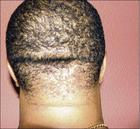
Trimming your hair yourself will help to prevent fungal infections.
Keisha Brown, Health Writer
Barber shops have historically been places where men have gathered for not only a haircut, but often for friendly talk about politics, sports and, of course, their women.
Prior to the advent of an easy-to-use, mass-produced safety razor in the early 20th century, a large percentage of men would visit the barber regularly - sometimes several times a week - to have their faces shaved. All these factors went into making the barber shop an important meeting of male minds.
But just how sterilised are those razors? How clean is your barber salon? Are you putting your health at risk by going there?
What you need to know
Every day, scores of men visit their barber for a haircut and/or shave. Some customers might be carrying the fungal organism responsible for ringworm infection. If the barber shop you frequent doesn't properly sterilise the equipment, you might be at risk for ringworm and other fungal infections.
Ringworm gets its name from its appearance, not from the agent that causes it. The characteristic feature of ringworm is patches of rough, reddened skin. The patches often contain circular lesions, open wounds, that look as if they were caused by tiny worms under the skin.
Over time, the lesions grow outward from the centre. The centre heals and becomes hard and crusty. But the outer edges of the lesions become inflamed and spread outwards.
Ringworm of the scalp is highly contagious. It can be contracted directly from person to person, as well as indirectly when infected persons leave the fungus on towels, hairbrushes or other objects. A second person may then contract the fungus while handling these objects. Certain conditions increase the risk of spreading the fungi that cause ringworm. These include dampness, humidity, and dirty, crowded conditions.
Symptoms
Ringworm of the scalp causes a diffuse, itchy, scaling of the scalp that resembles dandruff. There may be itchy, scaly round patches of hair loss on the scalp as well. Ringworm stubs of broken hairs form a dotted pattern on the scalp.
Ringworm of the beard is another important fungal infection. It affects bearded areas of the face and neck in adult men. Symptoms often include a thick, nodular patch of inflamed skin that may ooze pus, as well as crusted skin on the bearded regions.
Diagnosis
A medical doctor can examine you and diagnose the condition based on symptoms present. However, a culture will have to be taken to confirm the diagnosis.
Prevention
1. Avoid contact with infected persons and objects such as combs, brushes, hats, etc. that are likely to be infected.
2. Shave your face at home to avoid the risk of unsanitary razors touching your face.
3. Invest in an electronic razor and learn to do your trims yourself.
4. If you do go to a barber shop, stick to a specific barber who usually sterilises his equipment. If you have to go to another barber, ask a friend for a referral, and when there, don't be afraid to ask about sterilisation of equipment.
Treatment
Sometimes ringworm of the scalp can heal without treatment, but medical supervision is advised. A course of oral antifungal medications is usually prescribed.
Sources:
1. www.emedicine.com
2. www.americanchronicle.com

